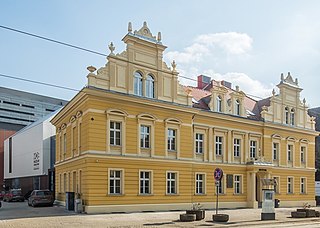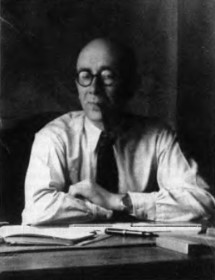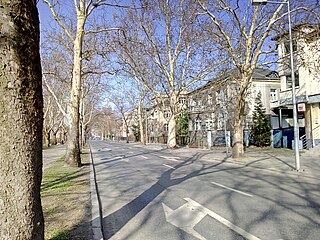
Freedom Square in Bydgoszcz is located in Bydgoszcz, Poland, in downtown area, between Gdańska Street and the park Casimir the Great.

Tenement Freedom Square 1 is an historic house of Bydgoszcz. It is often displayed on postcards as one of the turn of the century iconic building in Bydgoszcz. The architect, Józef Święcicki, is also the builder of the "Pod Orłem" hotel, the oldest hotel in downtown Bydgoszcz. The building is located on the east side of Gdańska Street, on the corner of Plac Wolności.

The District Museum Building in Bydgoszcz is an historical building in Bydgoszcz located at 4 Gdańska Street.

The Pomeranian Arts House is a building of cultural and historical significance located at 20 Gdańska Street in Bydgoszcz, Poland. It has housed chronologically:

The tenement at 22 Gdańska street is a tenement located in downtown Bydgoszcz.

The Villa Heinrich Dietz is a historical house in downtown Bydgoszcz, also called Villa Flora.

The Villa Wilhelm Blumwe is an historic house in central Bydgoszcz, registered on the Kuyavian-Pomeranian Voivodeship Heritage List.

The tenement at 91 Gdanska street is a historical habitation building located on Gdańska Street, in Bydgoszcz, Poland.

The Villa Fritz Heroldt is a historical house in downtown Bydgoszcz. It is registered on the Kuyavian-Pomeranian Voivodeship Heritage List.

Adam Mickiewicz Alley is one of the main streets of downtown district in Bydgoszcz, where several buildings are registered on the Kuyavian-Pomeranian Voivodeship Heritage List.

Ossoliński Alley is a large dual carriageway road located in downtown Bydgoszcz.

The Prevention Police Building is a historical administrative building in Bydgoszcz, Poland. It was initially an orphanage. It is located on the southern frontage of Jana Karola Chodkiewicza Street, at No. 32, in the eastern edge of downtown Bydgoszcz. It is registered on the Kuyavian-Pomeranian Voivodeship Heritage List.

Carl and Wilhelm Blumwe were German entrepreneurs, industrialists and businessmen in Bydgoszcz from the second half of the 19th century. Buildings connected to them are listed on several heritage lists.

Saint Andrew Bobola's Church is a church in downtown Bydgoszcz, Poland. It is located on Kościelecki Square. Its patron saint is the Polish Jesuit Andrew Bobola. The edifice, completed in 1903, was designed by German architect Heinrich Seeling. It was registered on the Kuyavian-Pomeranian Voivodeship Heritage List on December 15, 1998.

Jan Kossowski (1898-1958) was a Polish architect and builder, mainly associated with Bydgoszcz. His professional activity spanned from the interwar period to the 1940s. His artistic style is mainly connected with Modern Architecture.

Markwarta street is located in the downtown district of Bydgoszcz, Poland. Situated in its path are two green areas and several villas built during the Polish interwar period.

Józef Weyssenhoff Square is an open place in the downtown district of Bydgoszcz, Poland. Several of its buildings are registered on the Kuyavian-Pomeranian Voivodeship Heritage List.

The Church of the Savior is a neo-Gothic Lutheran church in Bydgoszcz. Located on Savior Square along Warszawska Street, it was called Christ Church till 1945.

The Bernardine Church of Our Lady Queen of Peace is a historic church from 1557, located in Bernardyńska street, in Bydgoszcz, Poland. Its patron was initially Saint George: in 1971, Polish primate Stefan Wyszyński changed its title to the current one.

The Sanatorium in Smukała is a hospital for pulmonary diseases located in the district of Smukała, Bydgoszcz, Poland. Located in a conifer forest, it operated as an independent institution between 1904 and 2000, before being integrated into the structures of the Kuyavian-Pomeranian Center of Pulmonology.




















































